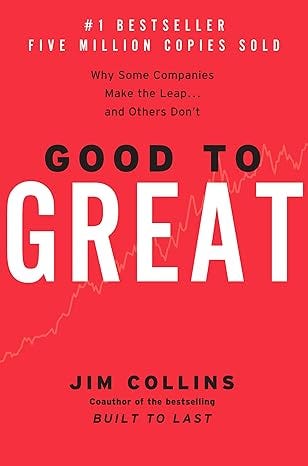What do 'Good to Great' companies look like today?
I read the best-seller book by Jim Collins, and it got me thinking about a 2025 version...
Jim Collins’ Good to Great remains one of the most influential business books of our time. But 20+ years later, what do great companies actually look like now?
Let’s revisit Collins’ key concepts and explore how they’ve evolved in today’s world of tech disruption, ESG demands, and rapid scaling.
Collins’ Key Ingredients of Good to Great
Reimagined for 2025
1. Leadership: From Humble CEO to Ecosystem Steward
Then: In Collins’ book, great leaders were characterised as quiet, humble, and resolute. No drama or ego, just a focus on planning and delivering results.
Now: Today’s great leaders still lead with humility, but they must also act as ecosystem stewards - balancing internal culture with external impact, tech, policy, and people. They are visible, mission-driven, and build beyond their companies.
🧠 Examples:
Satya Nadella (Microsoft). When he became CEO, Microsoft was seen as outdated. He rebuilt company culture around empathy, broke down silos, embraced open-source, and repositioned Microsoft as a cloud-first, AI-integrated ecosystem player with one of the world’s highest market caps today.
Melanie Perkins (Canva) leads with purpose and accessibility, while building a global creator ecosystem that reflects her values.
2. People: From “Right Seats on the Bus” to “Co-Builders of the Road”
Then: Hire the right people first (“get the right people on the bus”), then figure out what to do with them and where to drive the bus.
Now: You still need the right people, but the definition of right has expanded. You not only need good executors, but also strategic collaborators who thrive in uncertain, AI-powered, hybrid work environments. Companies today need co-creators who help shape the direction of companies and move fast. There is no longer time to wait for top-down direction in today’s tech driven environment.
The best people today are co-creators who move fast, challenge the status quo, and help build the road while driving. Core skills now include adaptability, communication, and managing shifting priorities, not just technical ability to execute seamlessly.
🧠 Example: Miro, the collaborative whiteboard company, scaled rapidly by building a globally distributed team of product thinkers and operators who didn’t wait for instructions. Their cross-functional squads co-develop with customers in real time, and internal teams are empowered to pivot quickly, which is critical in a fast-moving, remote-first SaaS space.
3. Facing Reality: From “Brutal Facts” to “Systemic Truths”
Then: In Good to Great, companies became great by confronting hard internal truths such as underperforming teams, bad strategies, financial missteps. Then, by responding with discipline and resolve. Denial and sugar-coating was never part of the recipe.
Now: Today, “brutal facts” extend beyond the boardroom. Growing companies now face systemic truths in the form of climate change, social inequality, AI disruption, geopolitical volatility that affect not just their bottom line, but their legitimacy as companies. Great companies don’t just need to face the truths, but also take public, structural action to show their commitment to it. Internal performance is still table-stakes, but greatness (standing out) in a more ‘woke’ world requires ownership of impact
🧠 Example: Patagonia didn’t just issue a sustainability report. In 2022, founder Yvon Chouinard gave away the company by transferring ownership to a trust and non-profit committed to fighting climate change. It wasn’t symbolic; it was structural. The company’s profits now fund environmental causes indefinitely making Patagonia a model for values-aligned business stewardship.
4. Hedgehog Concept: From Strategic Simplicity to Customer-Centric Obsession
Then: Collins’ Hedgehog Concept helped companies define their greatness by focusing on the intersection of three circles:
What you’re deeply passionate about
What you can be the best in the world at
What drives your economic engine
Now: The Hedgehog Concept still applies (it is one of my favourites in the business world!). But in today’s distracted, hyper-competitive world, companies must sharpen it further by delivering compounding value in their niche area. Great companies today obsess over delivering one thing that customers deeply value, better than anyone else, and continuously evolve that value based on feedback, behaviour, and culture. The “best in the world” bar keeps rising, and focus must adapt without losing clarity.
🧠 Example: Duolingo delivers a gamified, humorous, and sticky daily learning experience, instead of just teaching a language. It doesn’t get distracted by adjacent markets or feature creep. Instead, the company deepens its core: AI-powered lessons, memes, streak psychology, and lovable mascots. As a result, ~88% of users stick around for 7+ days, a rare feat in edtech.
5. Flywheel: From Internal Momentum to Compounding Network Effects
Then: The Flywheel Effect meant that great companies achieved greatness through a series of small, consistent wins that built momentum, instead of sudden breakthroughs
Now: That’s still true but the flywheel spins faster when powered by community, feedback loops, and data. Great companies today design their flywheels intentionally, so that every user interaction feeds growth, improves the product, and increases value for the next user. Virality, retention, and product-led growth are engineered into the experience.
🧠 Example: Figma built a flywheel where each user invited more collaborators, generated public files, contributed plugins, and educated others. Its feedback loop, from community to product to marketing, accelerated product development and market penetration.
In 2025, greatness means more than performance metrics. It means
Having ecosystem-driven, purposeful leaders
Hiring co-creative, agile, mission-fit teams
Embracing complex global truths + acting on them
Singular, evolving customer value prop
Compounding growth with feedback loops, community feedback, and data
Greatness today is all about resilience in chaos, clarity in noise, and impact at scale.
Built not only to win, but also to matter more and more, to customers and beyond
👇
Who do you think is a modern-day “Good to Great” company? Reply in the comments.
Till we meet again next week,
Nareen S.




